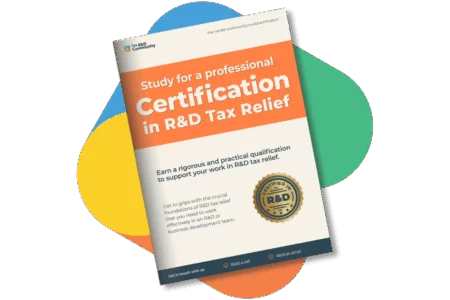With so much to keep on top of, even experts can often find themselves working right at the edge of their comfort zone, interpreting nuanced guidance and legislation for a variety of niche and unexpected situations.
Many experts in R&D tax relief like to think they get everything right, all the time – but when we put them to the test it turned out that wasn’t the case.
At the start of every R&D Certification programme, candidates take a Diagnostic Assessment, covering the core topics in R&D tax relief. This helps them identify their own areas of strength and weakness before they dive into the training itself.
What we discovered is that there are a few tricky areas where the majority of candidates make the same mistakes – even those who’ve been in the field for many years. Read on to find out if you’d avoid all these errors yourself.
Differences in eligibility for ERIS vs R&D Intensive claims
One of the most confusing areas of R&D tax relief is the small but very important difference in the qualifying criteria for the R&D Intensive Scheme and the Enhanced R&D Intensive Support (ERIS) Scheme – never mind the similarity in their names!
We ask candidates to identify the key criteria for each scheme from a list – the same list is given for each question.
Q1. To apply for relief under the R&D Intensive Scheme, the company must be:Q2. To apply for relief under the Enhanced R&D Intensive Support (ERIS) Scheme, the company must be:
- An SME
- Loss-making (before the enhanced deduction for R&D is applied)
- Loss-making (after the enhanced deduction for R&D is applied)
- A large company
- Spending at least 40% of its expenditure on R&D
- Spending at least 30% of its expenditure on R&D
- Spending the majority of its expenditure on R&D (i.e. more than 50%)
- Working with certain specified sectors
The correct answer is that to apply for relief under the R&D Intensive Scheme, an SME can be loss-making after the enhanced deduction for R&D is applied, and spending at least 40% of its expenditure on R&D.
To apply for relief under the ERIS Scheme, an SME must be loss-making before the enhanced deduction is applied, and spending at least 30% of its expenditure on R&D.
Would you be among the 12% of people who get both questions right?
Rules for claiming the cost of connected externally provided workers (EPWs)
Qualifying Costs is one of the 6 core topics covered by the programme, and it includes another area where we see a lot of mistakes with the more challenging questions.
We ask candidates to choose the correct rules for claiming the cost of connected EPWs. Here’s the question and the choices in full:
Consider the following facts:
- Company A and Company B are controlled by the same Director.
- Company A makes a payment to Company B to provide staff to work on Company A’s R&D projects.
- Company B pays those staff to work on Company A’s R&D projects.
Which of the following statements are true?
- Company A can claim for 65% of the payment to Company B
- Company A can claim for 100% of the payment to Company B
- Company B will claim relief on the costs of paying the staff
- Company A can claim for the amount that Company B paid the staff
- Company A can claim for up to 100% of the payment to Company B
While we are simplifying things slightly here, the correct answer is that Company A can claim for the amount that Company B paid the staff, and for up to 100% of the payment to Company B.
Only 34% of candidates correctly selected both options.
What qualifies as “tax advice” for AML registration
Another major portion of the programme looks at the ethics of R&D claim preparation, including a detailed look at PCRT and HMRC’s Standard for Agents.
Candidates also look at the rules for the Anti-Money Laundering supervision – and it’s a good thing they do, because this is another area where even experienced advisors make mistakes!
We asked candidates:
Which of the following activities would fall under “tax advice” and require your company to be registered for Anti-Money Laundering (AML) supervision?
- Helping a company decide which activities to claim for
- Altering tax returns to include R&D claims
- Advising a company how to apportion its costs
- Designing a better website for your client
- Giving the client general information about the R&D schemes
- Drafting narratives to explain the R&D to HMRC
The most common mistake was thinking that “Giving the client general information about the R&D schemes” counts as tax advice – but in a legal sense, it does not!
Only 32% of candidates correctly identified the four correct answers!
Who can claim subcontracted R&D under the SME scheme
As recently as February this year, HMRC published updates to their guidance on which companies can claim SME R&D tax relief when work was done under contract. For a few years, HMRC’s guidance, and view, was that any R&D undertaken to fulfil a customer contract could not be claimed by the subcontractor. Their position was that the company who paid for the work might be able to claim, but the issue was that often that company had no knowledge that R&D was even required, and didn’t have the Competent Professionals or baseline knowledge to support an R&D claim. This could lead to situations where neither the customer nor the subcontractor was able to claim, despite clear evidence that R&D had been carried out.
This was a real mess, and there were several high-profile tribunal cases which led to the revised guidance in February. Unfortunately, the new guidance still seems to be confusing!
Our first cohort of candidates were asked this question (in September 2024):
You are talking to an SME, which has carried out R&D for another SME. The subcontractor you’re talking to wants to claim through the SME scheme. In the SME scheme, HMRC generally takes the view that:
- The subcontractor can claim, as long as it decided to undertake the R&D
- The subcontractor cannot claim
- The company commissioning the work can always claim
- The company commissioning the work can claim if they can show they had an R&D project
Only 30% of the candidates correctly selection options 2 and 4.
The more recent cohort took the diagnostic in April 2025, so they answered a slightly different question that was based on HMRC’s new guidance:
You are talking to an SME (the contractor), which has carried out R&D for another SME (the customer). The contractor you’re talking to wants to claim through the SME scheme. From February 2025, HMRC adjusted its guidance to reflect the view that in the SME scheme:
- The contractor can claim if the R&D was incidental to the contract with the customer
- The contractor cannot claim because it was working for an SME
- The customer can always claim because they were paying for it
- The customer can claim if they had contracted out the R&D to the subcontractor
Still only 42% of people correctly identified the right answers (options 1 and 4) – perhaps we should let HMRC know that their updated guidance is still confusing R&D advisors!
The burden of mistakes in R&D tax relief
While these mistakes may seem quite academic, given the context, even small gaps in advisors’ knowledge can have a major impact on them and their clients.
Getting the wrong criteria for an ERIS scheme claim could lead to a company’s claim being rejected after a costly enquiry process, even though an identical claim through the merged scheme would have gone through without a hitch.
Not understanding the rules for connected EPW costs could lead to a client losing out on significant tax relief if the 65% apportionment is applied when it shouldn’t be.
Misunderstanding the rules for Anti-Money Laundering schemes could mean the company fails to meet legal obligations to make checks on clients. This could lead to hefty fines and being listed on a public register.
Without a clear understanding of the current and past guidance on when an SME subcontractor can claim, advisors could give the wrong information to a client, or potential client, leading to them missing out on a claim because they are still working by the older guidance. It has certainly led in the past to advisors submitting claims for subcontracted work which HMRC has later rejected as ineligible for that reason.
Small mistakes can have a major impact, so filling those knowledge gaps can make a big difference.
Filling the gaps in your knowledge of R&D
The results from the R&D Certification programme show that the majority of candidates have a better grasp of these kind of details and nuances after completing the training. When they re-take the Diagnostic Assessment at the end of the programme, we can see significant improvements in all areas. For these four topics in particular, 2-3 times more candidates got the correct answers compared with the first time round.
So, if you’re considering how to fill gaps in your R&D knowledge, how to clarify details that feel fuzzy, and what might give you and your clients confidence in your advice, you’re in the right place!
Download the Certification Prospectus today to get full details of the training programme and decide if it’s right for you.





